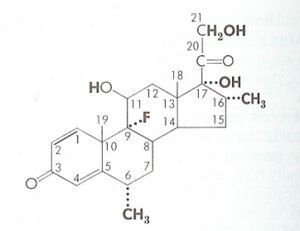Corticosteroids

The first corticosteroid used for its anti-inflammatory effect was Cortisone. The structure was modified leading to increases in the ratio of anti-inflammatory to sodium-retaining potency. In a number of currently available compounds, the electrolyte effects are now of no serious consequence, even at the highest doses used. In all compounds the effects on inflammation and metabolism of carbohydrates and protein have paralleled one another. The effects on inflammation and metabolism are likely mediated by the same type of receptor.
Changes in the molecular structure can cause changes in biological potency. This can be due to alterations in absorption, protein binding, rate of metabolic transformation, rate of excretion, ability to traverse membranes, and intrinsic effectiveness of the molecule at its site of action.
References
- ↑ Liddle 1961, Clinical Pharmacology and Therapeutics

